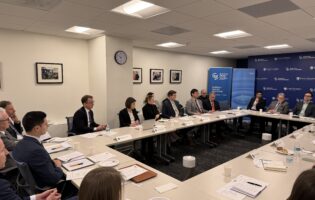Sustainable Urban and Regional Transportation Systems: Financing and Planning
On November 28, 2012, the American-German Institute (AGI) hosted the workshop “Sustainable Urban and Regional Transport Systems: Financing and Planning, ” made possible by a grant from the Daimler-Fonds im Stifterverband für die Deutsche Wissenschaft. The workshop was hosted within a larger program on sustainable mobility entitled the “Transatlantic Urban Climate Dialogue.” The panelists discussed differences between planning and financing of German and American transportation systems, specifically in the Washington, DC and Baden-Württemberg regions.
The workshop began with the premise that transportation is a public service, and thus requires public funding. To sustain the development of the Baden-Württemberg (the capital of which is Stuttgart) and DC regions, further reallocation of the budget should be made toward ensuring this public service. The current budgets are under threat from federal budget cuts. Further financing is needed to ensure quality and public goods such as less traffic congestion and affordable transportation to avoid social exclusion.
 The first panel focused on the planning process of transportation systems and the incentives for investing in this sector in each of the regions. The U.S. and Germany are two countries with some of the highest levels of car ownership, although ground passenger transport in Germany is less car dependent than in the U.S. Key
The first panel focused on the planning process of transportation systems and the incentives for investing in this sector in each of the regions. The U.S. and Germany are two countries with some of the highest levels of car ownership, although ground passenger transport in Germany is less car dependent than in the U.S. Key lessons are that involvement of different planning levels and sectors guarantees coordination of transport, land-use, and financing, and that a coherent planning blueprint that is developed with broad stakeholder participation can engender stable, efficient, and dynamic redevelopment. Policymakers should understand that any significant changes in individual behavior, land-usage, and transportation systems take time.
lessons are that involvement of different planning levels and sectors guarantees coordination of transport, land-use, and financing, and that a coherent planning blueprint that is developed with broad stakeholder participation can engender stable, efficient, and dynamic redevelopment. Policymakers should understand that any significant changes in individual behavior, land-usage, and transportation systems take time.
View Ralph Buehler and Wolfgang Jung’s presentation on “Sustainable Transport in Germany”
 Next, the discussion focused on financing these changes. If public transportation is a public service, then its funding should rely less on fare-box recovery rates (which are around 33 percent in the U.S. and 70 to 75 percent in Germany), and continue to look for alternative sources of funding. Some of these sources are already being explored in Germany and the U.S. and include toll roads, higher fuel taxes and insurance fees, and transit funding from the federal, state, and municipal levels. There is a need to continue looking for new sources of funding as public transportation costs increase at a faster rate than general inflation.
Next, the discussion focused on financing these changes. If public transportation is a public service, then its funding should rely less on fare-box recovery rates (which are around 33 percent in the U.S. and 70 to 75 percent in Germany), and continue to look for alternative sources of funding. Some of these sources are already being explored in Germany and the U.S. and include toll roads, higher fuel taxes and insurance fees, and transit funding from the federal, state, and municipal levels. There is a need to continue looking for new sources of funding as public transportation costs increase at a faster rate than general inflation.







